It is in France, and notably in the south and southwest, that we have the fullest and most nearly continuous evidence of the very ancient occupation by man of the European lands. All the phases of this occupation, so far as they have been established, are represented in the Department of Charente.
The Department includes the whole of the old Province of Angoumois and parts of Limousin, Perigord, Saintonge, and. Poitou. Its chief town, Angoulême, the Ecolisma or Engolisma of Gallo-Roman times, is built on a high promontory formed at the junction of the Anguienne with the river which has given its name to the Department. From the ramparts one looks down on parklike meadows threaded by the clear, quiet waters which Henry IV called affectionately “the fairest streamlet of his realm.” These ramparts enclose much history, old as we commonly reckon it, modern by comparison with all that has passed in the valley of the Charente since the first hunters stalked the elephant and the hippopotamus on its banks. The city gave to England a queen, that Isabel whom John Lackland with characteristic violence and disregard for decency carried off from her betrothed, Hugues of Lusignan. Francis, Count of Angoulême and Duke of Valois, afterwards Francis I of France, spent part of his childhood with his sister, “the Marguerite of Marguerites,” in the château, one of the two surviving towers of which, now incorporated in the Hertel de Ville—the round tower, called “of Valois”—is especially associated with the early days of the future Queen of Navarre. It was a Charentais, Ravaillac, by whose hand fell her grandson, Henry IV.
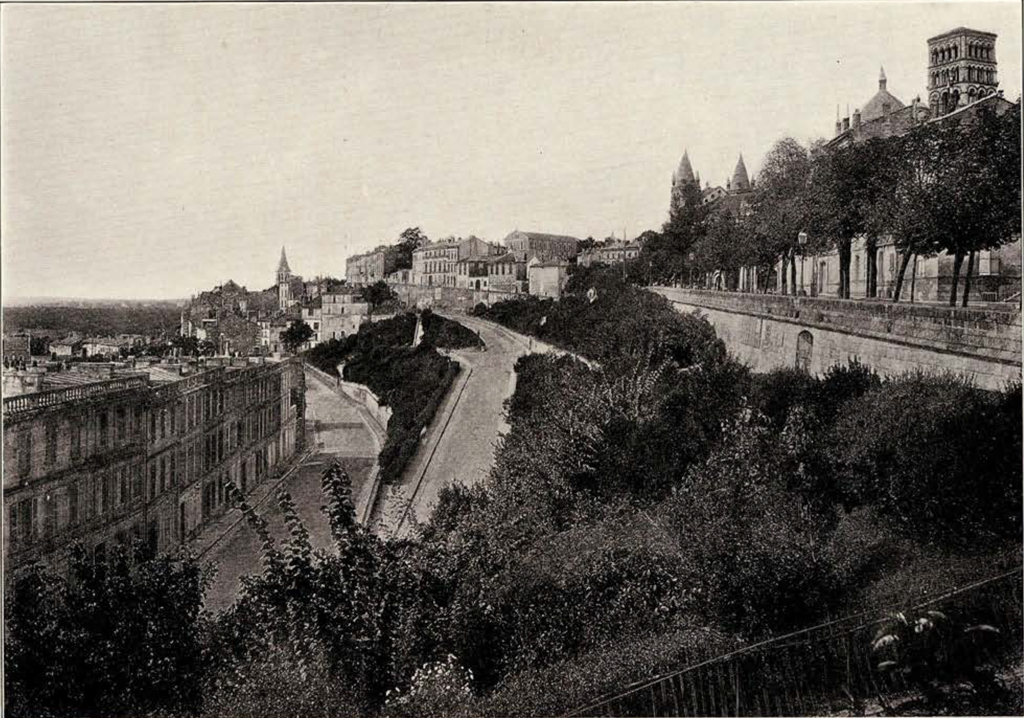
Image Number: 22993
From the early Christian centuries onward, indeed, this country was known for many other deeds of blood committed on one side or other of the pale that marked off orthodoxy from heresy. Clovis, with his newly baptized sword, brought his Franks against the Arian Visigoths who had held Aquitaine since its cession to them by Honorius. He passed by Angoulême lest he should be delayed too long by the strength of its position from the work he had to do further south and east, only to return and enter the city through a breach caused by the accidental collapse of a part of its walls. He put the heretics within to the sword, as he had done in the rest of southern Aquitaine, while the bishops acclaimed the barbarian as purger of the Church from the heresy of Arius.
During the religious wars of the 16th century Catholics and Protestants possessed the city by turns, and their respective successes were marked by similar measures of repression, until the revocation of the Edict of Nantes sent the bulk of the dissenters to death or exile.
Politically, so far as it is possible to distinguish religious and political questions in those earlier times, the Charente has undergone no fewer changes and chances. The Charentais were known to Latin writers as Santones. The people of Angoumois are -nowhere distinguished as a separate tribe, and there is no reason to suppose that the Ecolismians, set apart as a political unit by Honorius, were ever in fact anything but a branch of the Santones.
The Roman occupation must have added a considerable strain of Italian blood to the ancient population. The remains of Roman villas found in the basin of the Charente, about Saintes and up to the foot of the walls of Angoulême, bear witness to the permanent and thorough character of the occupation. Yet the primitive element in the population must always have dominated from the racial point of view; while accepting the benefits of civilization from the conquerors, there is little reason to doubt that this population preserved in the main its national character and indigenous type. Even at the present time, in the country about Angoulême, although blonder individuals are frequently met with, the preponderating element is markedly of the swarthy Mediterranean type.
The Visigoth domination lasted a much shorter time than that of the Romans. From their capital at Toulouse they ruled the country by virtue of its cession to them by Honorius. Admixture with the native population must have been limited by acute religious differences, for the Visigoths, as we have seen, were Arians. Clovis was able to profit by these differences. The orthodox clergy prepared the people for the invasion of the Franks, representing the latter as liberators. The Charentais preferred their yoke, for the Visigoths had not respected the religion of the country, but had expelled orthodox bishops and made over their sees to Arian prelates.
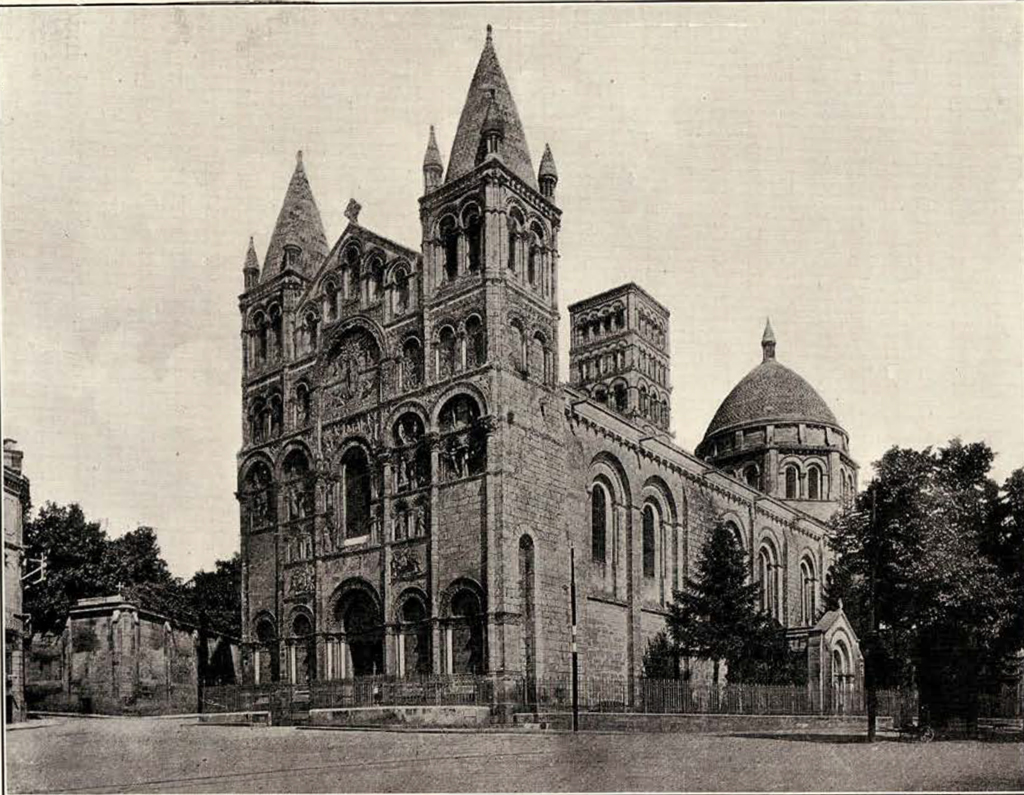
Image Number: 22994
Yet the Charentais had little sympathy for the northern barbarians, who did not, in any case, penetrate far into the south as settlers; their settlements chiefly centred about the Loire and the Meuse. Even as late as the 16th century southern writers spoke of the Charente, and especially of Angoumois (to which these remarks particularly refer), as “the lands on this side” (les pais de par deça), by way of expressing this local particularism. There were frequent revolts against the Frankish rule; and though the country yielded to the sword of Charlemagne, scarcely had power begun to languish in the hands of his grandsons, when the people resumed their independence and willingly accepted the feudal regime which ensured self determination to local patriotisms without number. Thus the Frankish blood mingled little with that of the Engolismians.
This racial or national particularism being taken into account, the same thing must be true, a fortiori, of the Saracens or Moors, though these popular names for alien infidels survived curiously enough in one locality until the middle of the last century, perhaps still survive, in the family names Maurin and Sarrazin. As for the Normans, it is probable that their expulsion by the Counts of Angoulême was complete.
The Counts were created for the defence of this town and its dependencies, which had been ravaged successively by Romans, Vandals, Visigoths, Franks, Saracens, Basques, and Normans. The first line of Counts, made hereditary by Charles the Bald, is known as the House of Taillefer, after the nickname of the third in descent from the first hereditary Count. This nickname was bestowed on William I, who is said to have met in combat a Norman captain and to have cleft him, mail and all, open from the crown of his head down to his chest. The Taillefers ruled, often in practical independence of the kings, from the middle of the 9th century to the end of the 12th, when Angoulême was taken (1193) by Cceur de Lion, who claimed it through his mother. During the next two centuries, the English claim was several times revived before the town was definitely ceded in 1360, by the Treaty of Bretigny. The English were however expelled in 1373. In the meantime, the Taillefers had been succeeded by the House of Lesignan or Lusignan, in the person of that Hugues of whom we have spoken, and who recovered his bride, Isabel Taillefer, after the death of John Lackland. With her he received the County. In 1303, with the extinction of the House of Lusignan, the County reverted to the Crown of France, and its history as an independent or semiindependent unit ceases.
The written word apart, there is no lack of monuments of this long history: remains of Roman roads, villas, temples, fortifications, of chapels, hewn from the rock, whose beginnings doubtless go back to the early Christian centuries, of mediaeval fortresses, of castles of every subsequent century down to the eighteenth, and of churches which are, in part at least, of equal age.
All these may serve to illustrate the written annals of the past. For the history of the earlier ages we must ourselves supply the text from the illustrations, left fortuitously in the ground by the people whom the Romans conquered and by their forerunners, but left abundantly in this ancient land. Megalithic monuments or shrines, fortified camps, objects of iron and bronze and stone, take us back to the ages of which written history has nothing to say, but which we have named from the materials of which prehistoric men fashioned the things of which they had daily present need, taking no thought for the curiosity of the future.
Of the two periods or phases into which the iron age, or first prehistoric epoch of western Europe, is commonly divided, the remains in the Charente, so far as they have been discovered, are the least important in quantity.
More numerous relics of the preceding, or bronze, age have been found. In the museum of the Archaeological and Historical Society at Angoulême a few objects representative of this period are to be seen. They are considered to have been the handiwork of a settled, agricultural population which still occupied the country towards the 10th century B.C., had much skill in the manufacture of pottery without the wheel, and, to judge from the development shown in their work in metal, must have inhabited the region for a long period of time.
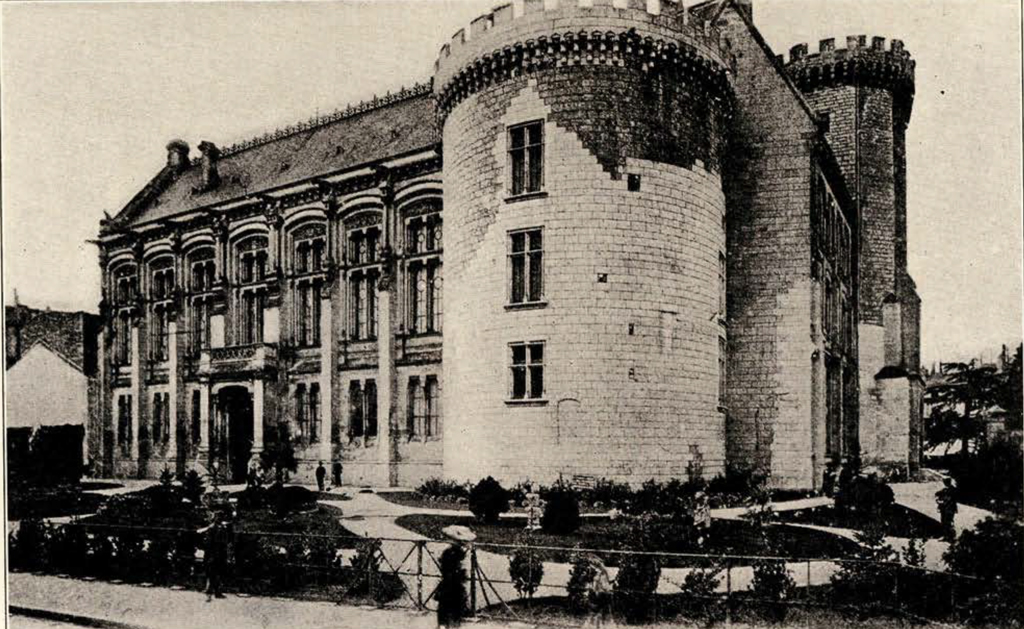
The neolithic, or new stone age, when men had invented a new process for finishing their stone tools and weapons by grinding or polishing them and had learnt to make pottery but not to use metal, is well represented in the Charente. To this age belong the dolmens, and some of the tumuli and fortified camps of the region. as well as numerous flint workshops of the plateaux. The burials sometimes contain rich funerary offerings, evidencing a well developed cult involving a belief in the survival of the soul. With the neolithic populations other important marks of progress, besides a new method of dealing with stone, make their appearance. Pottery was made, although as we have seen the potter’s wheel had not yet been invented, animals had been domesticated and the cultivation of plants had been begun. In the later dolmens metal begins to make its appearance in the form of ornaments—beads of copper and sometimes of bronze. So far as actual proof to the contrary has appeared, hunting had been the only source of the food supply in earlier ages and no doubt continued to be an important industry in neolithic times. The fauna in the Charente was much like that of the present day, with a much greater abundance of wild animals.
Neolithic times perhaps go back some 10,000 years. During a vastly longer period than this, known as the paleolithic, or old stone age, man had been undergoing a long and slow development evidenced by the improvement in his tools, and the evolution of an artistic sense culminating in the remarkable art of the upper palæolithic, which for beauty of outline in drawing and carving was not surpassed in later prehistory.
The gap which was formerly believed to separate the new from the old stone age has been filled by discoveries of industries which show a transition from the one to the other. Of these, that known as the Azilian, from the station of Mas d’Azil in the Pyrenees, is the best defined. It is represented in the Charente by at any rate one station. The stone industry is characterized by the presence of many microliths or minute implements probably employed in the working of the bone weapons and implements which become increasingly abundant in the upper palaeolithic.
Still reckoning backwards, the next period of the upper or later palaeolithic—the succession of periods is determined by the superposition of the archæological layers in which the relics of ancient man are found—is that known as the Magdalenian, from the type station of La Madeleine in the valley of the Dordogne. All these periods are named from the places in which the characteristic industries were first recognized.
In the Charente the Magdalenian is represented by several stations, among them the grotto of Le Placard in which a human skull, typical of the principal race of the upper palaeolithic, was found. This race is usually known as that of Cro-Magnon, from the place where its skeletal remains were first recognized. It differed but little, apparently, from existing races, much less so than the race which was responsible for the industries of the older palæolithic.
In the Magdalenian period the stone industry had become decadent. The place of stone tools and weapons was taken to a considerable extent by objects fashioned from bone, ivory, and the antlers of reindeer. From these materials were made barbed harpoons, awls, needles, polishing tools, etc.
An abundance of mineral colouring matter is found in the deposits of this period, oxides of iron and manganese, such as were used in the caverns of the Dordogne, the Pyrenees and northern Spain for the famous wall paintings which the work of the Abbe Breuil in particular has made so well known. This was the great period of palolithic art, when most remarkable carvings in bone and ivory also were accomplished. The favourite subjects were realistic representations of animals. A typical implement of the period, found also in the two previous phases of palolithic industry, when the beginnings of graphic art make their appearance, is the graving tool of flint. Small flint implements similar to the Azilian microliths occur.
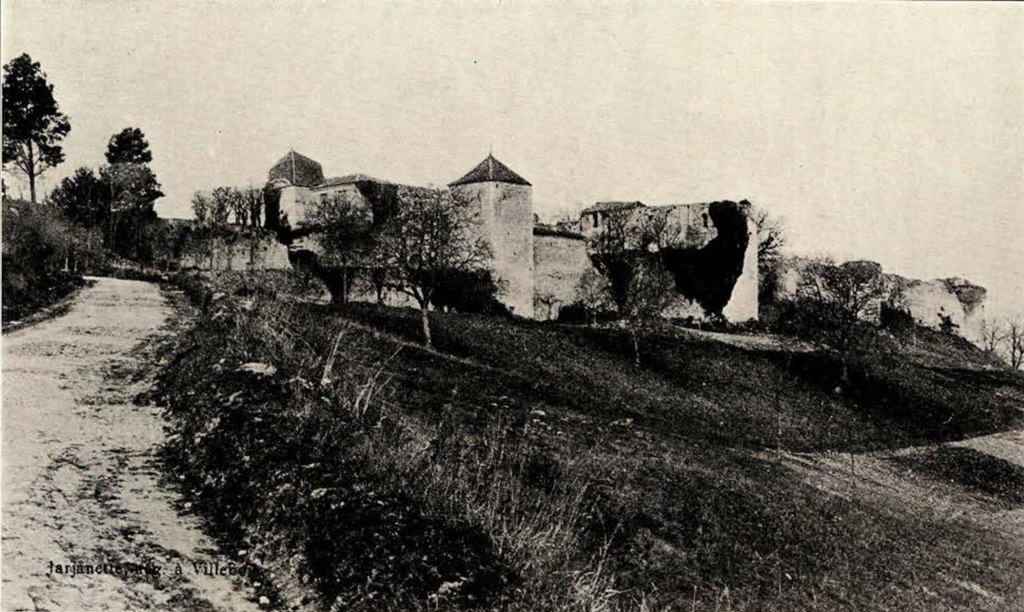
The period in which the old stone industry reached its highest degree of perfection was that which immediately preceded the Mag-dalenian—the Solutrean. Splendid large flint blades or lance heads in the form of a laurel leaf, chipped across the whole of both faces —the characteristic “Solutrean retouch”—so as to reach an extraordinary thinness in proportion to their large size, are the masterpiece of the period. The bone industry, of points, polishers, etc., shows considerable improvement, notably in the slenderness of the points, over that of the preceding stage. The grotto of Mouthiers and the rock shelter of Combe-á-Rolland, together with the grotto of Le Placard, already mentioned in connection with the Magdalenian, represent the Solutrean in the Charente. It is possible to regard the Solutrean as a later development, merely, of the next earlier period.
Next in descending order is the Aurignacian, with which phase commences the upper or later palæolithic. It is represented in the Charente by several stations, notably those at Pont-Neuf, not far from Angoulême, in the commune of La Couronne, and at La Quina, near Villebois-Lavalette. The latter place however is much more famous, as we shall see, for its remains of the next earlier period, known as the Mousterian. Graving tools of flint, which served to make the first line engravings on bone or ivory and on stone, appear in the Aurignacian for the first time. The bone industry is represented by points large and small with cleft bases, which probably served for hafting them to wooden shafts as arrows and lances. Flat polishing implements made from the ribs of animals, and bone or ivory pendants, together with long slender pins, are numerous.
The geologic age of these palaaolithic phases of human industry is still the subject of discussion. Numerous attempts have been made to assign each to a definite period of the advance or retreat of the ice during the glacial and interglacial epochs which occupied the pleistocene or quaternary geological era, immediately preceding that in which we live. Certainly the phases just enumerated coincided with the later quaternary, and developed in the midst of a “cold fauna,” i.e., one consisting of animals whose nearest existing relatives, or more lately extinct representatives, are known in arctic or subarctic surroundings. This is shown by the bones of the animals which are found mingled with the flint implements and weapons of the men who hunted them—reindeer, mammoth, woolly rhinoceros, saïga antelope, musk ox, chamois, together with others capable of adaptation to such a climate—certain other species of ox and deer besides the musk ox and the reindeer.
The next period in descending order, the Mousterian, must have been of long duration during the middle quaternary. The earliest hitherto clearly recognized preceding cultures, the Chellean and the Acheulian, were respectively contemporary with a warm and a (partly) cold fauna. It is thought by some that the earlier, the Chellean, may date from the early quaternary.
It is of the period known as the Mousterian, from the type station of Le Moustier in the Dordogne, that the Charente contains the finest and most thoroughly studied remains. About twelve miles southeast of Angoulême is the village of Villebois-Lavalette, clustering about an old castle which crowns a commanding height with a fine view over rolling country. Villebois is one of the most ancient baronies of Angoumois. The Lords of Villebois were lieges of the Counts of Angoulême. The castle includes the remains of a romanesque chapel. The tall ramparts, partially restored and generally in a fair state of preservation, may date from the 12th century. The keep was demolished in the 17th century when the modern chateau, now in disrepair though partially restored, was built.
About three miles from Villebois, near the old mill of La Quina, the escarpment of a low plateau is skirted by a road constructed about forty years ago. In the course of this construction a number of flints and bones were turned up, and further excavations were undertaken along the base of the steep slope at the level of the roadway. In 1905 systematic excavation of the site was begun by Dr. Henri Martin and has been pursued by this distinguished archaeologist unremittingly ever since. Through the courtesy and with the advantage of the teaching of Dr. Martin, who owns the site, the American School in France for Prehistoric Studies worked at La Quina during the summer of 1921 under Dr. McCurdy of Yale, during that of 1922 under Dr. Peabody of Harvard, and it is expected to return for a shorter visit in September of this year, under Dr. Hrdlicka of Washington. During the present season the writer has gratefully enjoyed a similar privilege.
Dr. Martin’s long labours, of first class importance for the study of the period which he has made peculiarly his own, have their fitting monument not only in his published works but in the museum and laboratory of his country house at Le Peyrat which contain a splendid collection of Mousterian flints and of the abundant remains of animals which occur in the deposits at La Quina near by. Portions of the skeletons of twenty human beings, including two crania, of Mousterian age found by Dr. Martin at La Quina are in Paris, together with numerous specimens of flint implements and of utilized bones of animals. Of the latter two categories large collections remain at Le Peyrat. Through the generosity of the administration of the Museum of St. Germain and of Dr. Martin a selection from these has been presented to the University Museum.
It is from the study of the bones of the deposits that Dr. Martin has obtained the most interesting results of his excavations in the way of filling in the outlines of the story of the Mousterians of La Quina taken from the local features of their habitat and the study of their stone implements. What follows here is an abstract of his conclusions.
The man of La Quina, whose skeletal remains show him to be a typical representative of the race commonly known as that of Neanderthal, from the place where a skull cap and other skeletal fragments were found near Dusseldorf about seventy years ago, belongs to the genus Homo, but differs so much in his anatomical characters from Homo sapiens, the modern race, that he must be placed in a sub-genus. He was not an ape, but he was no more than just a man. Short and thickset, somewhat bent, with curved thighbones, he had a very long head, very large eyes under enormous super-ciliary arches, a prognathous face almost without cheekbones, and a massive lower jaw. The absence of forehead indicates a brain poorly developed in the region which corresponds to the centres of intelligence.
The cold climate of the epoch made shelters necessary and the man of La Quina sought refuge in holes in the cliffs of the escarpment. He may have increased the comfort and safety of his lodging by means of screens formed of branches, or he may even have built huts; naturally, in the course of thousands of centuries all traces of his use of wood have disappeared. Often he made use of tiny grottoes, mere niches, in which he crouched, and where he has left numerous traces of his occupation.
Before him flowed a wide river which washed the foot of the cliff, the escarpment of the plateau over which roamed the animals he hunted. In the course of ages this great sheet of water has dwindled into the rivulet now known as the Voultron.
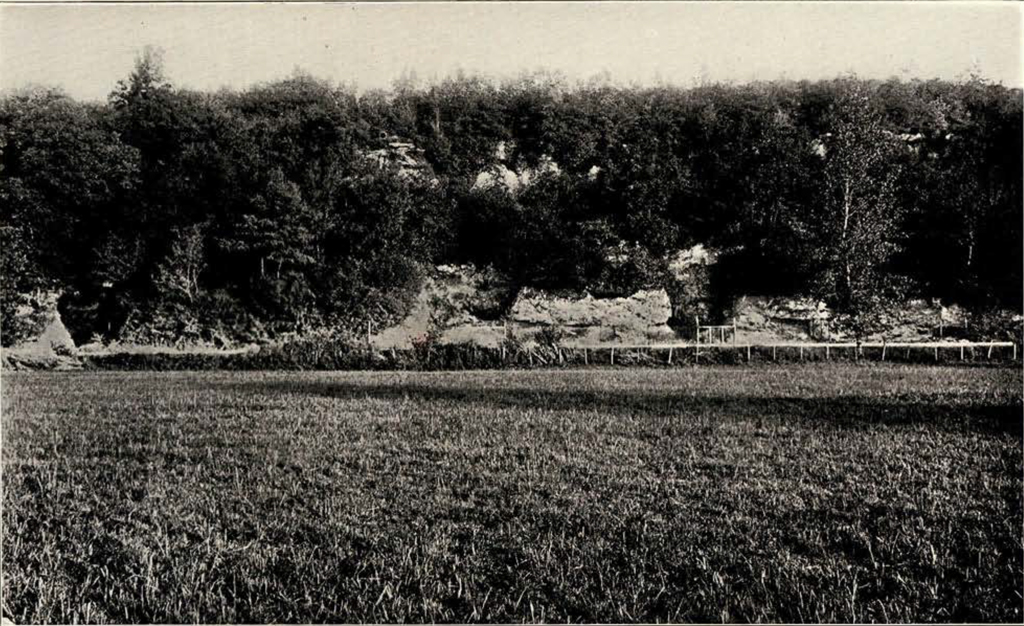
Image Number: 22877a
From the chalk he got the flint nuclei which he split up into flakes with the aid of heavy hammer stones of quartz. These flakes were converted into blades and points and other cutting or scraping implements by a more delicate technique of percussion which cleverly shaped the outlines of the tool or weapon. The fragile edges, sharp as a razor at first, were easily dulled. Splinters of bone were then used to remove by pressure small flakes so as to restore the cutting edge. These bits of bone are extremely numerous in the station, but their use was not recognized until it was determined by Dr. Martin in 1905.
Axes or tomahawks seem to have been fitted with flint heads trimmed on both faces, and long flint points, with bases apparently flaked thin for hafting, must have been among the weapons of the chase. Stones which were certainly intentionally rounded, sometimes into perfect spheres, were evidently used as projectiles, thrown perhaps by means of slings.
Whatever wooden implements they used have of course disappeared. But blocks consisting of the phalanges of the horse and of the lower extremity of the humerus of the ox, which show well defined patches of intercrossing cuts in the bone, are evidence of the employment of pointed weapons of wood. Placed on the ground, these blocks probably received these impressions from the cutting edge of the flint blade which trimmed to a point the end of the stick resting on the block.
Their weapons must have been used chiefly in the chase of the animals which supplied the Mousterians with food and for defence against the savage beasts which attacked man in his shelters or in the open. A great cat and the cave bear were no doubt their most formidable enemies. There is no evidence that the men of this period turned their weapons against each other. In the Museum of Natural History at Toulouse there is to be seen a human vertebra pierced by a flint arrow or lance head which still remains in the wound. But this striking relic of ancient human feuds is from the neighbourhood of a grotto in Ariège, that of Montfort, an Azilian station, and therefore of much later date, at the close of the palæolithic.
On the other hand Dr. Martin has found at La Quina equally direct evidence, if such were needed apart from the innumerable traces of human manipulation of the bones of animals in the station, of the use by the Mousterians of flint weapons in the chase in the form of a flint point embedded in one of the bones of the foot of an ox. Two species of these beasts, one probably a bison, the other an ox of enormous size, together with the reindeer and the horse were the principal objects of the chase, for the bony remains of these animals are extremely abundant in the station. The mammoth, being a more difficult quarry, has left fewer traces there.
Captures were evidently made near the settlements, since all parts of the skeletons of these animals are found in the debris. This would not be the case if the animals were killed at a distance; for then the carcases would have had to be cut up on the spot and carried piecemeal to the shelters, the parts useless for food or other purposes being left behind. It would have been impossible for these extremely primitive hunters to convey the carcase of a mammoth or of an ox nearly the size of an elephant for any distance. Probably the chase was of the nature of a drive and was contrived so as to end in some sort of cul de sac, natural or artificial, at the settlement.
Dr. Martin’s admirably methodic and painstaking examination of the bony dejecta of the station reveals with astonishing clearness the manner in which these ancient hunters dealt with their quarry. It is shown from the nature and position of the cuts made by the stone implements on the bones near the principal articulations of the head and limbs how they dismembered the animals, probably to share the meat among the members of the hunting party; from marks on the inner face of the ribs and vertebrae how the carcases were eviscerated; from cuts made at the base of horns or antlers, along the sternum, and at the extremities of the limbs, how the skin was carefully removed, presumably to be converted into such rude clothing as they could contrive to protect them from the cold.
If the men of La Quina commonly ate their meat raw, it seems certain from the not very numerous remains of calcined bones that they were not ignorant of the art of cooking. The accusation of cannibalism which has been brought against these forerunners of modern man is not borne out by evidence of manipulation, like that to which the bones of animals was subjected, on any of the skeletal remains of twenty individuals of Mousterian age found at La Quina.

